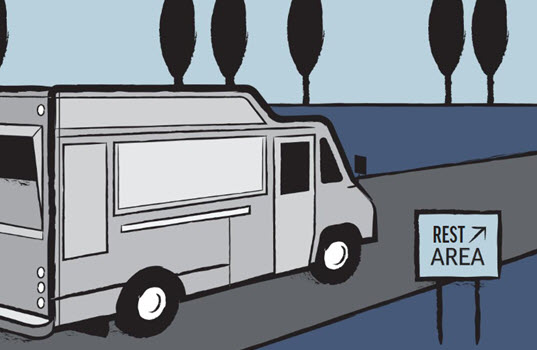By Keith Reid
The push to commercialize rest areas is one of those issues that never seems to fully fade, even though it similarly lacks the ability to gain notable traction. In the latest round, the Federal Highway Administration (FHWA) announced on April 3 that states may allow food trucks to operate at rest areas within the interstate highway system (with the required licensing) through June 15, as a response to the disruptions from the COVID-19 pandemic. Industry organizations, specifically NATSO with the support of 10 other associations including NACS, PMAA and SIGMA, had no significant objections to the policy—with one significant caveat.
“I do want to make sure it’s clear that we did not ask FHWA to rescind the order stating that they would not enforce the prohibition during the national emergency,” said Tiffany Wlazlowski Neuman, NATSO’s vice president, public affairs. “And what we asked them to do was to withdraw the non-enforcement notice after the declaration of emergency is over.”
The commercialization of rest areas has been barred since the earliest days of the development of the Interstate Highway System in the 1950s. The goal of the prohibition was to preserve the economic viability of smaller communities adjacent to the new highways that might otherwise be bypassed. That remains the case today, aside from grandfather provisions in several states that had already moved forward with development.
The occasional push to reverse the ban finds support in some states that see this as a potential revenue source. There are also arguments that commercialization would increase truck parking capacity.
Truck stop and convenience retailers (among other impacted parties) and the organizations that represent their interests broadly oppose these initiatives. They point out that any new revenue would, in effect, cannibalize business from existing retail outlets and directly harm local communities. NATSO also contends that research shows truck parking capacity decreases in areas where commercialization is allowed.
Further, changing the rules of the game would harm retailers, who in many cases have been serving interstate customers for generations. To add insult to injury, retailers would likely be denied the chance to compete for the business opportunities associated with commercialization. The primary retail operations would be a small handful of multinational companies like those found running retail operations in airports, for example.
The national and local responses to the COVID-19 pandemic created a range of extraordinary actions, and at times chaos, that invariably resulted in quick solutions to problems that in hindsight may or may not have been significant. In the case of the FHWA food truck decision, the outcome was a mixed bag.
Keeping Trucks on the Road
Supporting drivers during the pandemic has been a priority, and for long-haul truckers, that means meals, fuel and rest time. A combination of truck stops and convenience retail typically support these functions.
“In March, a lot of states and local jurisdictions said that the sit-down restaurants could no longer provide dining service,” said Wlazlowski Neuman. “What our members did was make numerous adjustments to accommodate the restrictions such as transitioning to curbside, takeout delivery or providing hot meals from their dining-in restaurants for pickup at the deli or a convenience counter. So, we were providing a lot of food options for drivers.”
NATSO also worked with the International Franchise Association to provide information on the IFA website about where food was available at member truck stops.
In most cases, drivers had ready access to meals through conventional sources. However, that was not absolute.
“The Florida Petroleum Marketers Association pointed out that there were some routes in the middle of the state where the smallest guys weren’t able to stay open,” said Paige Anderson, director of government relations at NACS. “Ned Bowman at FPMA has been a powerhouse on this and other issues. And the question was, how do we make sure the truckers get fed? But, as always, when there’s a need we find solutions.”
Unfortunately, what was a relatively minor problem was perceived, for a time, to be much more serious in some areas.
“There were some states that temporarily closed their public rest areas, and we learned pretty quickly that the public and the media don’t always know the difference between a truck stop and rest area,” said Wlazlowski Neuman. “It was being reported that truck stops were closed, and that was never the case.”
Under the non-enforcement order food trucks could access rest areas, but they had to follow often-onerous state permitting processes—if the states decided to allow permitting—any many did not. As a result, the primary activity has been in a handful of states such as Arizona, Arkansas, California, Florida, Idaho, Indiana and Ohio.
While the pandemic’s painful economic impact on convenience store and truck stop operations has been well documented, not to mention the devastation to dedicated sit-down restaurants, reports on the impact to food trucks have been contradictory.
The National Food Truck Association has stated that up to 40% of food trucks are shutting down temporarily or permanently. Food trucks have traditionally relied on crowds, whether that is the lunch rush in a business area or a festival or event. Such opportunities are obviously far scarcer during lockdowns.
On the other hand, the mobility of the food truck concept allows a truck operator to seek out remaining pockets of activity and even new pursue revenue opportunities. It’s easy to find headlines touting food truck success stories—but not necessarily at rest areas.
“The irony is that this basically started in Arkansas because there was this perceived problem, but the food truck folks decided they weren’t getting any business at the rest areas, so they ended up moving,” said Anderson.
What will come next?
There is always the concern that once an initiative like allowing limited commercialization moves forward, it makes it easier to pursue such goals more aggressively. The previous effort to allow the commercialization of rest areas in President Trump’s $2 trillion infrastructure plan in 2019 saw Congress soundly defeating the initiative in a bipartisan manner.
But a lot has changed in such a short time, and state budgets, many of which have long been strained, are now under extreme pressure after the losses incurred from the lockdowns. And states may be grasping at straws for potential revenue sources, even those with a questionable payback.
Conversely, the same pressures have ramped up for local municipalities and the retail locations that call them home.
The National League of Cities estimates that cities, towns and villages will be facing a $360 billion shortfall. Rest area commercialization may put money in state coffers, but it will come out of the budgets of the interstate-adjacent municipalities. And the impact on trucks stops and convenience stores would be another burden on already-strained operations. The industry associations whose members will be the most impacted are watching the aftermath closely to make sure this policy area returns to normal, along with the rest of society as the lockdowns end.
 Keith Reid is the editor of Fuels Market News.
Keith Reid is the editor of Fuels Market News.









